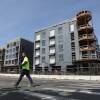The city of Worcester’s homeless population has risen to nearly 500 people, a 43% increase over the past year, according to city human services officials.
The nonprofit Central Massachusetts Housing Alliance conducted the count in March and April and found 551 homeless people total in Worcester County. About 90% of those residents live in the city of Worcester and most have shelter indoors.
By comparison, a year ago, 347 homeless people were counted in the city of Worcester.
During a Worcester City Council public health and human services committee meeting Tuesday, city officials said the increase in homelessness stemmed from police in surrounding communities dropping homeless people off in Worcester for treatment and services. Local hospitals and rehabilitation centers also tend to discharge homeless patients even if they have no plan for housing.
At the same time, Worcester lacks enough affordable housing to help people avoid homelessness.
“The demand is much higher than the supply,” said Councilor Morris Bergman.
According to Zillow,median rent in Worcester is currently $1,800, up $200 over the last year. Housing values across the city also have skyrocketed 117% since 2011. As a result, about 50% of Worcester renters are cost-burdened, meaning they’re paying over 30% of their income on rent and utilities.
During Tuesday’s meeting, city officials and councilors said the high cost of housing is causing many people to become homeless and preventing others from leaving homeslessness. Some people who do escape homelessness and find an apartment become homeless again because they can’t afford increases in rent.
“Housing is the issue,” Worcester Commissioner of Health and Human Services Matilde Castiel said. “We can give as much treatment as we want, but without having the housing … the effect is still the same — that there’s homeless people out in the community.”
According to Massachusetts’ subsidized housing inventory, just 13.5% of Worcester’s housing stock is designated affordable for low- to moderate-income households. Massachusetts’ two other largest cities have a higher proportion of affordable housing: 21% in Boston and 16% in Springfield.
Several low-income housing projects are meant to help address homelessness in Worcester. The city’s housing authority is planning 24 units along Lewis Street, and a group of housing developers and the Worcester East Side Community Development Corporation will build a tiny village along Stafford Street. The Main South Development Corporation is also building 46 affordable units at 92 Grand St.
Still, Worcester officials have expressed concerns that may not be enough to meet demand. Last year, the city created an affordable housing trust fund to help finance affordable housing development, and they’ve reserved money from the American Rescue Plan Act to address the housing shortage.
The city is also considering mandating that developers include a certain percentage of affordable units in new housing developments via an inclusionary zoning ordinance.








